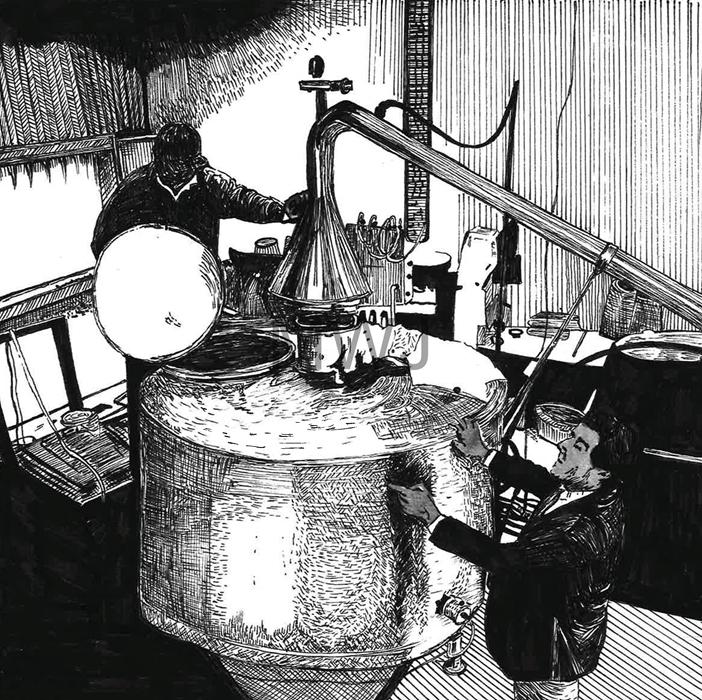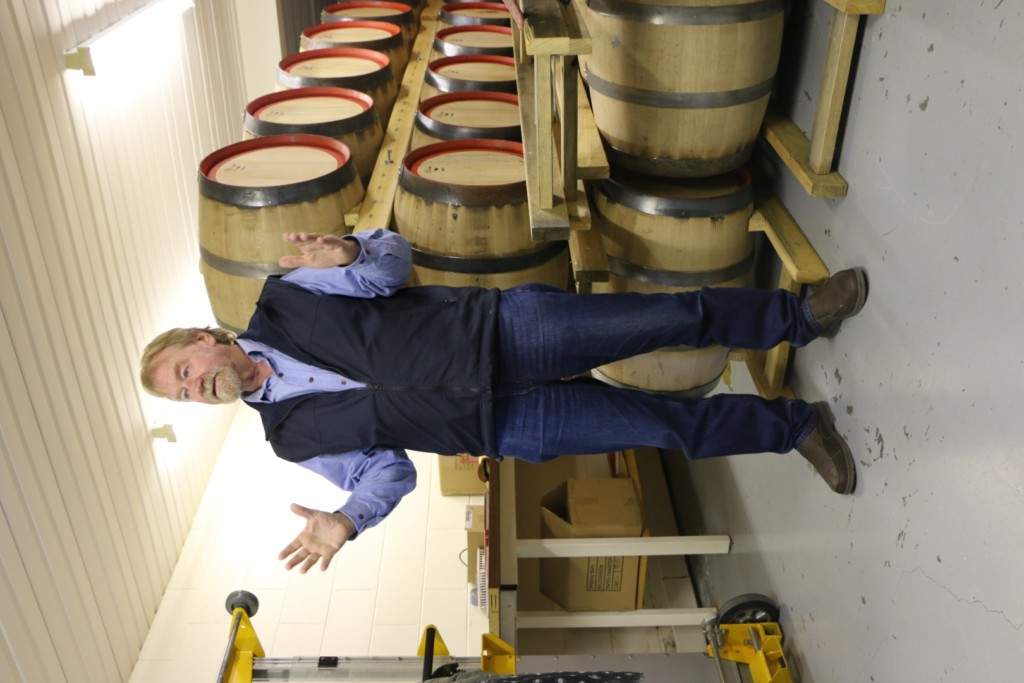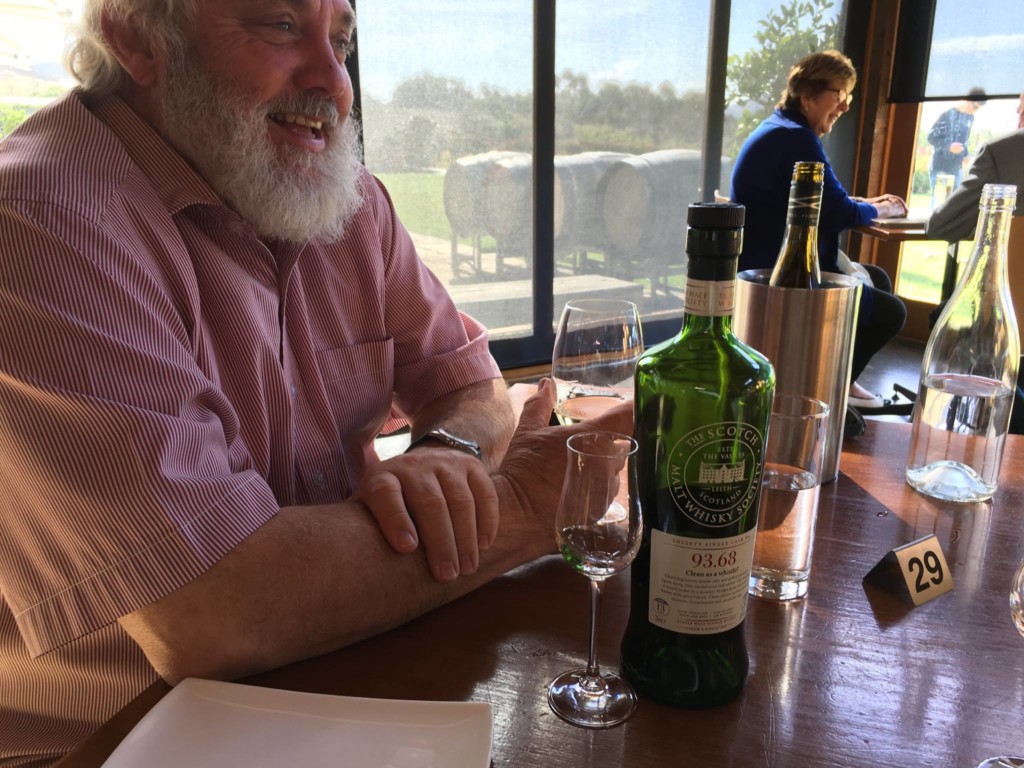The following article was written by our own Cellarmaster and NSW State Manager for the SMWS, Andrew Derbidge. Chapter 2 chronicles the rebirth of the industry and where it’s landed today. This full article plus more is in our August 2021 Outturn which features the Society’s first-ever, panel-approved single cask Australian whisky. Keen to learn more and want to join Australia’s leading single cask whisky club? Join here.
Chapter 2 – The Great Reinvention
By Andrew Derbidge
My first encounter with Australian whisky was around 2001 when one of the first releases of Sullivans Cove – the one in the fancy decanter bottle – appeared in a few independent bottle shops in Sydney. It retailed for around $80, at a time when Lagavulin 16yo retailed for $55. It had been bottled and released locally in Hobart just a year or two earlier, and it was the first widely distributed commercial Australian whisky endeavour of the new era. Sadly, the quality of what was inside the decanter was extremely poor, doing the newborn category no favours.
When the 2000 edition of Michael Jackson’s “Malt Whisky Companion” came out (for those not familiar, Jackson’s book was considered the whisky equivalent of the Wisden Cricketers’ Almanack), the section at the back devoted to “International whiskies” listed both the aforementioned Sullivans Cove, plus one of the early Cradle Mountain releases. The reviews and scores assigned to both whiskies were less than flattering. With the ghost and spectre of Corio lingering in the memories of many, this is the backdrop against which many drinkers became aware that Australian whisky was a thing once more.
You’ll note that the name Lark does not appear in the preceding three paragraphs. Even in the earliest years of the industry’s re-birth, it seems there was a distinction between making craft whisky and actually making a commercial or retail venture of it. But let’s go back to the beginning and start with Episode IV…

Early days at Cradle Mountain distillery
Despite most references to the early days revolving around Bill Lark’s determination and incredible efforts (and we’ll explore that in just a moment), the first whisky of the modern era was distilled by Brian Poke in 1991 (or 1989, depending on who you believe) by what – after a few name changes – would come to be known as the Small Concern Distillery Company. The company had been formed a few years earlier and was established to test the suitability and viability of the newly developed Franklin variety of barley for the production of malt whisky. It was a short-lived affair, filling two casks only, and the distillery had essentially been dismantled by 1992. In 1993, a then-15 month old sample was taken to Cadenhead in Scotland (the independent bottling company under the same family ownership as the Springbank distillery) who were impressed enough to order some casks – and they provided $25,000 in funding to help re-establish the distillery and to re-commence production. Small scale production ran from 1994 to 1997, and the whisky would go on to be sold in the early 2000’s under the name of Cradle Mountain. Meanwhile….
The Lark story is a good one and takes longer to tell than space here permits. The executive summary is that Bill Lark, together with his wife, Lyn, decided to try his hand at distilling and make whisky in Tasmania. However, the local government’s distilling act had not been updated in over 150 years and had been drafted to effectively discourage distillation on account of the widespread alcohol abuse in the colony at that time. Legal distilling required a minimum still size that was prohibitive, and the last licenced distillery in Tasmania closed in 1839. Distillation on the “domestic scale” that Lark intended was thus illegal, and Lark lobbied and worked with his local MP to get the legislation amended. This was no small task and changing legislation does not happen overnight, nor without hard work and co-operation. After a concerted effort, the act was changed in 1990. Bill did his necessary homework, procured the required equipment and established his operation in 1992. The Larks then quietly went about distilling…..in their kitchen at home.
With the distillation act updated, others entered the scene. Robert Hosken bought himself an old brandy still and established the Tasmania Distillery (branded as Sullivans Cove) in 1994. Hosken was more entrepreneur than distiller, and the story goes that the distillation cuts were wider than they should have been, resulting in some aggressive spirit. This was subsequently filled into casks that either hadn’t been charred or had not been seasoned with a previous filling – making for a pretty rough and unrefined whisky! This was the spirit that would be filled into those fancy decanters and be released and distributed commercially throughout Australia, giving the brand – and perhaps the category – an unfortunate reputation. New owners took over Sullivans Cove in 1999 and began the process of adopting better distillation and maturation regimens. Patrick Maguire was amongst the staff at the time, and Patrick would go on to acquire the distillery in 2003 and become its figurehead.
In 1999, Hellyers Road was established in the north-west of Tasmania by a dairy milk company looking to diversify its interests, bringing the number of operating distilleries to three, and all in Tasmania. However, late 1999 saw distillation cross the Bass Strait, with David Baker establishing Bakery Hill on the outskirts of Melbourne. Australian distillery count: Four.
Of course, the catch with whisky is that it needs time to mature and so – apart from the Sullivans Cove and Cradle Mountain releases – nothing more really rose to the surface, unless you visited the local markets in Hobart where Bill and Lyn Lark were selling their wares. This changed in 2003 with the inaugural Australian Malt Whisky Convention that was held in Canberra that year. Curated and organised by the Malt Whisky Society of Australia (MWSoA), this was the event where Bakery Hill launched its first commercial releases, all at just a touch over three years old. Bottled releases from Lark were also showcased, and Mark Littler of Hellyers Road shared and gave insight into what they’d been up to in Burnie (although matured stock was not yet ready). For the first time, and at a national level, the Australian “whisky appreciation community” was engaging with the Australian whisky “industry”.

Overeem founder Casey Overeem
In the years immediately following that first Malt Whisky Convention, more distilleries were established whose names are now commonplace today: In 2004, Limeburners set up in Albany, Western Australia, and Southern Coast Distillers – today known as Tin Shed Distilling Co, responsible for the Iniquity brand – set up in South Australia. The second and third Malt Whisky Conventions (Sydney in 2005, and Melbourne in 2007 respectively) grew and fostered increased interest and attention on Australian whisky, and more distilleries followed: 2007 saw the establishment of the Old Hobart Distillery (branded and sold as Overeem), 2008 saw the establishment of Nant (Tasmania), and the first spirit flowed off the stills at Victoria Valley (Victoria) in 2009. Victoria Valley would later change its name to Starward. Australian whisky distillery count: Nine.
With the exception of Hellyers Road, all of the distilleries mentioned above were small concerns at this time. Production runs were small; releases were invariably single casks that could be inconsistent from one release to the next; and distillers were still learning how their spirit best worked with their local climate and the casks they were experimenting with. The much warmer temperatures and the drier climates meant that the practices and traditions that were well-established in Scotland were less applicable here. The ready and more affordable supply of casks from our wine industry also encouraged distillers to use local wine casks for maturation. There were hits and there were misses. But when the hits hit…
Recognition and attention on a global scale came in the form of medals being awarded at international spirits shows, and a number of Australian releases also did extremely well in Jim Murray’s annual Whisky Bible publication – Bakery Hill and Nant, in particular, drew high praise. But a seismic shift occurred in 2014 when a single cask release of Sullivans Cove won the World’s Best Single Malt award at the World Whiskies Awards. Australian whisky suddenly had international attention like never before, and the industry kicked into overdrive in more ways than one. There was an explosion of distilleries being established all over the country and the number of distilleries skyrocketed. Today, the number of distilleries making whisk(e)y in one form or another (barley malt, rye, grain, bourbon, etc) is said to be over 120. Around 65 of these currently have matured stock available that is now being retailed and sold.
Another twist to the modern Australian whisky story has been the inevitable rise of the independent bottler. With many distilleries now prepared to sell their immature spirit to a third party that will subsequently mature the spirit and bottle it under an independent label, it can be a win-win situation for the distilleries looking for faster revenue. Tim Duckett, via his two labels – Heartwood, and Tasmanian Independent Bottlers – leads the pack in this regard, crafting the spirit in his own unique ways to create whiskies that have won multiple awards and accolades overseas. Interestingly, and in a similar vein, a small number of Australian start-up distilleries in recent years have taken a leaf out of the Irish whiskey industry’s “How to start a distillery” playbook, and acquired third party spirit that they’ve sold under their own brand to establish their name and presence while they wait for their own-made spirit to mature.

Bill Lark
Four other noteworthy points round out this chapter and our history to date: The first relates to some corners of the industry being corporatised and seeing big business step in. Australian Whisky Holdings – a company essentially formed as an investment arm – acquired Lark, Overeem, and Nant distilleries, and – for a time – a small share of Redlands/Old Kempton. (Although Overeem would subsequently be bought back by the Overeem family a few years later). Across Bass Strait, Distill Ventures, a subsidiary of drinks giant, Diageo (owners of Johnnie Walker and roughly 30 Scotch whisky distilleries), acquired Starward in Melbourne. In contrast to the early and small distilleries that were typically “mum and dad” operations (and these still typify the majority of Australian malt whisky distilleries, mind you), new distilleries are now being set up as subsidiaries or offshoots of larger companies. 23rd Street Distillery (owned by the Bickford Group) and Morris Whisky (Morris of Rutherglen, the fortified wine company) are two such examples.
The second noteworthy point – and perhaps a counterpoint to the first – is the passing of the baton to a second generation of distillers within the family. Bill & Lyn Lark’s daughter, Kristy Booth-Lark, has established her own highly-respected distillery and brand, Killara. David Baker, whilst still at the helm himself, has brought his sons into the business, and Andrew Baker is increasingly the face and voice of Bakery Hill. And Casey Overeem’s daughter, Jane Sawford, together with her husband Mark, is now behind both the Overeem and Sawford distilleries.
The third point is the industry coming full circle again and seeing the re-emergence of Australian blended whisky. Starward’s launch of Two-Fold in 2018 – a blend of single malt from Starward and grain whisky distilled from wheat by Manildra – did not just bring the blended category back to life, but also introduced an Australian whisky at a significantly lower price point well below what consumers had become accustomed to seeing for Aussie whisky.
The fourth noteworthy point is the Australian industry expanding well beyond malt whisky, and embracing other cereals and mashbills. Tiger Snake, first distilled by Limeburners in 2007 and bottled in 2012 was the frontrunner in this field, and is essentially an Australian-made bourbon. Whipper Snapper in Western Australia is similar in this respect. Rye also features prominently in the mashbill at several distilleries, and some – such as Belgrove in Tasmania and Archie Rose in Sydney – have won significant awards and praise for their ryes. Furthermore, the emergence of mass-produced grain whisky from wheat has encouraged new styles and mixed mashbills, and also created a new category of Australian whisky: A sub-$100 price point!
The last five years, that is, 2016-2021 have seen unbelievable growth in the Australian industry, not to mention change. There are new players; new brands; new releases, new products showcasing experimentation with grain, yeast, and casks; and – importantly – new consumers. Generalisations and stereotypes that might once have hit the mark a decade ago are now wide of it. Our industry is increasingly difficult to pigeonhole or capture in a simple summary, such is the diversity now on offer.
The current Australian industry can no longer be called “fledgling”, as it was for so many years. This second era is now 30 years old and we’ve chalked up a few achievements – some good, some bad – that prove we’ve stepped out of our baby shoes. We’ve had corporate fraud and scandal; we’ve had a distillery fire; we’ve had distilleries passed on to the next generation; and we’ve won major international awards. The Scotch whisky industry did all those things, too……and it turned out okay.
Cheers,
AD
Andrew Derbidge is the Chairman, Cellarmaster, and NSW State Manager for the SMWS in Australia. He’s also written extensively on Australian whisky at whiskyandwisdom.com








